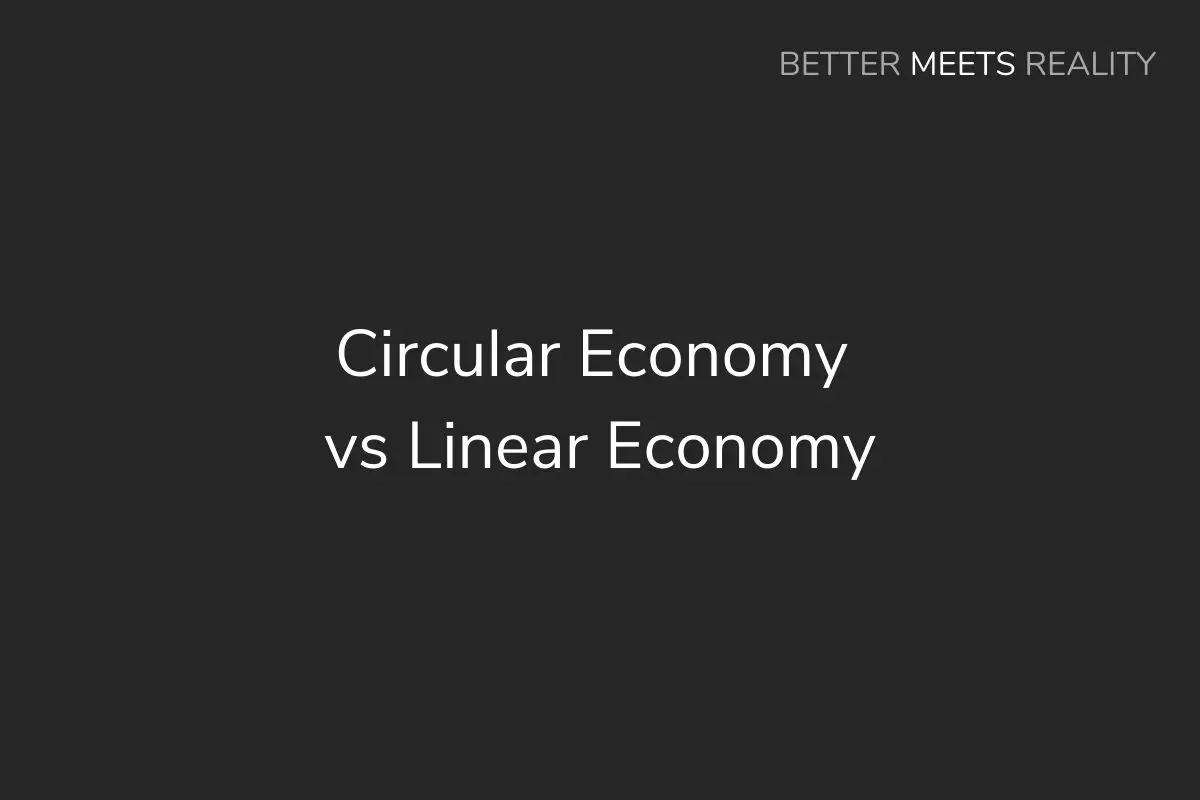In the guide below, we compare the model of a circular economy vs a linear economy.
We outline what the potential key differences between them might be, and also consider which might be better, and why.
Firstly, Do Circular & Linear Economies Actually Exist?
It might be accurate to describe both as concepts or models only.
Although circular economies might have principles and goals that are different to linear economies, there might be no such thing as a 100% linear economy, or a 100% circular economy.
Most economies might be hybrid economies that have practices that align more with one or the other.
For example, most economies still send waste to landfill, however, many economies also reuse materials and products, and use waste management practices like recycling and composting. So, these economies use a mix of practices that align with either concept.
Circular Economy vs Linear Economy: What Are The Key Differences?
A Circular Economy
Circular economies might have more of a focus on sustainability and environmental conservation.
Circular economies aim to keep materials and resources circulating in the economy.
These materials and resources are circulated from what would normally be the disposal stage, back to the manufacturing or usage stages, via practices such as recycling, reuse, and other practices
Circular economies might aim to reduce waste generation, reduce pollution, and achieve other sustainability and environmental goals
The lifecycle for products and materials in a circular economy might generally involve the following:
Manufacturing > Usage > Reuse, Recycling & Other ‘Circular’ Practices > Remaking Or Remanufacturing Products & Materials From Existing Materials & Resources
So, there’s an emphasis on reusing non virgin materials and resources again, and circulating them back into the economy after use instead of being disposed of and lost from the economy
A Linear Economy
Compared to a circular economy, a linear economy might place more focus on meeting consumer demand and a producer’s desire for profits
A linear economy doesn’t always place a focus on circulating materials and resources back into the economy after they’ve served their primary use
Instead, materials can be disposed of to places like landfills, or even directly into the environment
In landfills, these materials and resources usually no longer have value and can no longer be used in an economic sense
When waste is dumped, leaked or emitted directly into the environment, there’s also environmental pollution and environmental degradation to consider
A linear economy may also rely more heavily on extracting new resources from the environment rather than reusing existing ones
The lifecycle for products and materials in a linear economy might generally involve the following:
Take Virgin Resources From The Environment > Make Or Manufacture From Virgin Resources > Usage > Dispose Of Waste > And, Sometimes Pollution Or Environmental Degradation Caused By Waste
Some reports describe the linear economy process as ‘Take (take virgin or finite resources from the environment), Make, Waste’, as opposed to the ‘Make, Reuse, & Remake Or Recycle’ process in circular economies
Other Potential Differences
Some of the other potential differences between the concepts might be:
– Circular economies might focus more on reusing resources, whereas linear economies might focus more on extracting new resources
Aside from reuse that doesn’t involve any processing, another example of reusing resources might be closed loop recycling which may use more existing materials and less new raw materials than open loop recycling
– Circular economies might focus more on conserving nature and the environment (or regenerating it), whereas linear economies might result in leaks and emissions into the environment where pollution or degradation can be an issue
– Circular economies might be considered to use more closed loop systems, and linear economies more open ended systems
– Circular economies might be more ‘Cradle to cradle’, where there’s more of a focus on quality of products, vs linear economies might be more ‘Cradle to grave’, where there’s more of a focus on quantity of recycled materials or reduced waste
– Circular economies might prioritize longer lifespans for products and materials, whereas linear economies might prioritize profit for producers, affordability and product/material performance for consumers, and so on
Circular Economy vs Linear Economy: Which Might Be Better?
In General
It depends on the indicator being assessed.
In a very general sense, circular economies might be better for sustainability and the environment, whilst linear economies might be better in a practical and economic sense (at least at this point in time).
However, some reports indicate that there may be some uncertainty as to which is best.
For example, wikipedia.org mentions that ‘… there is a lack of clarity as to whether the circular economy is more sustainable than the linear economy, and what its social benefits might be …’
It might ultimately depend on the individual waste management systems and practices of individual cities and towns, rather than trying to make one generalized conclusion.
Individual Indicators
When considering individual indicators …
In some instances, circular economies might be better for waste prevention and waste reduction.
In some instances, linear economies might be better for speed, convenience and cost of production and consumption.
Other Guides On Circular & Linear Economies
A Circular Economy: What It Is, Principles, Examples, & More
Potential Pros & Cons Of Circular Economies
Linear Economies: What They Are, Examples Of How They Work, Potential Pros & Cons
Sources
1. Various ‘Better Meets Reality’ guides
2. https://en.wikipedia.org/wiki/Circular_economy
','' ); } ?>